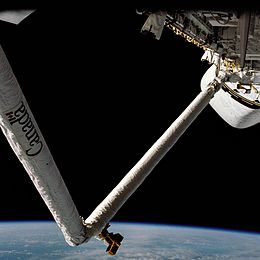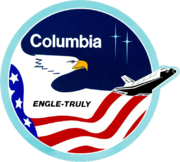 Canadarm's in-flight test during STS-2 | |
| Names | Space Transportation System-2 |
|---|---|
| Mission type | Flight test |
| Operator | NASA |
| COSPAR ID | 1981-111A |
| SATCAT no. | 12953 |
| Mission duration | Achieved: 2 days, 6 hours, 13 minutes, 12 seconds Planned: 5 days |
| Distance travelled | 1,730,000 km (1,070,000 mi)[1] |
| Orbits completed | 37 |
| Spacecraft properties | |
| Spacecraft | Space Shuttle Columbia |
| Launch mass | 104,647 kg (230,707 lb) |
| Landing mass | 92,650 kg (204,260 lb) |
| Payload mass | 8,517 kg (18,777 lb) |
| Crew | |
| Crew size | 2 |
| Members | |
| Start of mission | |
| Launch date | November 12, 1981, 15:10:00 UTC (10:10 am EST) |
| Launch site | Kennedy, LC-39A |
| Contractor | Rockwell International |
| End of mission | |
| Landing date | November 14, 1981, 21:23:12 UTC (1:23:12 pm PST) |
| Landing site | Edwards, Runway 23 |
| Orbital parameters | |
| Reference system | Geocentric orbit |
| Regime | Low Earth orbit |
| Perigee altitude | 222 km (138 mi) |
| Apogee altitude | 231 km (144 mi) |
| Inclination | 38.03° |
| Period | 89.00 minutes |
| Instruments | |
| |
 STS-2 mission patch  Engle and Truly | |
STS-2 was the second Space Shuttle mission conducted by NASA, and the second flight of the orbiter Columbia. The mission, crewed by Joe H. Engle and Richard H. Truly, launched on November 12, 1981, and landed two days later on November 14, 1981.[1] STS-2 marked the first time that a crewed, reusable orbital vehicle returned to space.[note 1] This mission tested the Shuttle Imaging Radar (SIR) as part of the OSTA-1 (Office of Space and Terrestrial Applications) payload, along with a wide range of other experiments including the Shuttle robotic arm, commonly known as Canadarm.[2] Other experiments or tests included Shuttle Multispectral Infrared Radiometer, Feature Identification and Location Experiment, Measurement of Air Pollution from Satellites, Ocean Color Experiment, Night/Day optical Survey of Lightning, Heflex Bioengineering Test, and Aerodynamic Coefficient Identification Package (ACIP).[2] One of the feats accomplished was various tests on the Orbital Maneuvring System (OMS) including starting and restarting the engines while in orbit and various adjustments to its orbit.[3] The OMS tests also helped adjust the Shuttle's orbit for use of the radar.[3] During the mission, President Reagan called the crew of STS-2 from Mission Control Center in Houston.[4]
In the early planning stages of the Space Shuttle program, STS-2 was intended to be a reboost mission for the aging Skylab space station.[note 2] However, such a mission was impeded by delays with the Shuttle's development and the deteriorating orbit of Skylab. Skylab ultimately de-orbited on July 11, 1979, two years before the launch of STS-2.[5]
- ^ a b "NASA – STS-2". NASA. Retrieved May 9, 2008.
 This article incorporates text from this source, which is in the public domain.
This article incorporates text from this source, which is in the public domain.
- ^ a b Becker, Joachim. "Spaceflight mission report: STS-2". spacefacts.de. Retrieved December 30, 2017.
- ^ a b Evans, Ben (November 12, 2016). "Flying a Used Space Shuttle: 35 Years Since the Short Mission of STS-2 (Part 1)". Retrieved December 30, 2017.
- ^ Wilson, Jim. "NASA - Remembering Ronald Reagan". NASA. Retrieved December 30, 2017.
 This article incorporates text from this source, which is in the public domain.
This article incorporates text from this source, which is in the public domain.
- ^ Shayler, David (2001). Skylab. Berlin: Springer. p. 311. ISBN 1-85233-407-X.
Cite error: There are <ref group=note> tags on this page, but the references will not show without a {{reflist|group=note}} template (see the help page).